Hi,
This blog we'll look at one of Magrittes early influences- Fantômas. Magritte takes his narrative images from the movie series directed by Louis Feuillade in 1913-14. "The only way to capture Fantômas is to enter his dreams." [Magritte-from his writings]
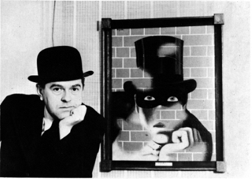
Magritte as Fantomas posing with his painting Le barbare, 1928
Fantômas — a figure of unmotivated evil, moral transgression and diabolical perversity — exerted a powerful fascination for French avant-garde painters and poets for three decades:
The books and movies that came out in quick succession anticipate by nearly one century the current production methods of Hollywood, in two respects: First, the authors distributed the writing among themselves; their "working method was to draw up the general plot between them and then go off and write alternate chapters independently of each other, meeting up to tie the two halves of the story together in the final chapter". This approach allowed the authors to produce almost one novel per month. Second, the movie rights to the books were immediately snapped up. Such a system ensured that the film studio could produce sequels reliably. One of the most popular characters in the history of French crime fiction, Fantômas was created in 1911 and appeared in a total of 32 volumes written by the two collaborators, then a subsequent 11 volumes written by Allain alone after Souvestre's death. The character was also the basis of various film, television, and comic book adaptations. His importance in the history of crime fiction cannot be overestimated, as he represents a transition from Gothic novel villains of the 1800s, to modern-day serial killers.
Fantômas's background remains vague. He might be of British and/or French ancestry. He appears to have been born in 1867. In the books, it is established that c. 1892, the man who later became Fantômas called himself Archduke Juan North and operated in the German Principality of Hesse-Weimar. There he fathered a child, Vladimir, with an unidentified noblewoman. In circumstances unrevealed, he was arrested and sent to prison. Fantômas was introduced a few years after Arsène Lupin, another well-known thief. But whereas Lupin draws the line at murder, Fantômas has no such qualms and is shown as a sociopath who enjoys killing in a sadistic fashion.
Fantômas is a fictional character created by French writers Marcel Allain (1885–1970) and Pierre Souvestre (1874–1914). He is totally ruthless, gives no mercy, and is loyal to none, not even his own children. He is a master of disguise, always appearing under an assumed identity, often that of a person whom he has murdered. Fantômas makes use of bizarre and improbable techniques in his crimes, such as plague-infested rats, giant snakes, and rooms that fill with sand.
René Magritte returned to the iconography of Fantômas repeatedly. The composition of a 1926 painting, The Threatened Murderer or Menaced Assassin (L'assassin menacé), in which two detectives, Juve and Fandor, lie in wait for Fantomas on either side of a doorway, is taken from Louis Feuillade's third Fantômas film Le mort qui tue (The Murderous Corpse).
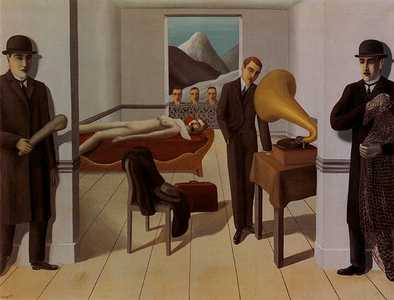
The Threatened Murderer (L'assassin menacé)-1926
Here's my analysis: Magritte provides this narrative- Fantômas has just killed a woman, and having placed a pure white cloth over her upper chest, pauses to listen to a record on the phonograph. Outside the room, three witnesses stare into the inner room. Juve and Fandor (two detectives closest) threaten to capture Fantomas, one with a cudgel, the other with a net. Clearly Fantômas is surrounded (threatened) but is he worried? No..."because he always escapes and even passes through walls." [The Beribboned Bomb By Robert James Belton]
Belton relates that Magritte's painting may be based on the case of murderer Henry Landru who in 1922 was executed for murdering several women for their money.
PART THREE: THE MURDEROUS CORPSE 1913-1914
Narrative: Juve is missing presumed dead from the house explosion and Fandor is investigating on his own. Fantomas imitates an old woman who trades stolen goods and Juve is made up as a hapless homeless man who helps her. A nam is framed for a murder, then killed in prison, then abducted from the prison. Fantomas makes gloves out of the man’s hands and commits more murders leaving the dead man’s fingerprints behind. The detectivess are mystified, but Fandor comes across a list of the murder victims in the order they’re killed. He finally visits Juve again, Lady Beltham reappears for a minute. Our heroes end up tracking Fantomas to a house and cornering him in the one place where there was a secret trap door. Whoosh, through the trap door and our heroes are empty-handed except for the skin-gloves.
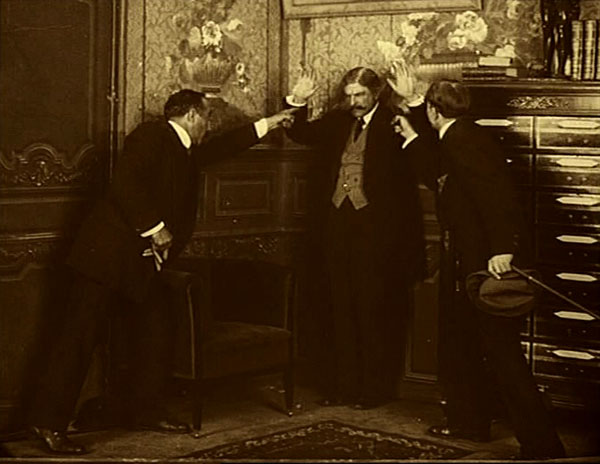
Photo from Louis Feuillade's third Fantômas film Le mort qui tue (The Murderous Corpse) 1913-1914
Note the skin gloves in the right hand
In his 1926 painting Man of the Open Sea (L'homme du large) Maggrite employs elements from the final scene of Feuillade's second Fantômas film Juve contre Fantomas, in which the Man in Black raises his arms in triumph after throwing the lever that destroys a house in which Juve and Fandor are trapped. In the painting below we see that Fantomas in his black garb is preparing to pull the lever to blow up the house.
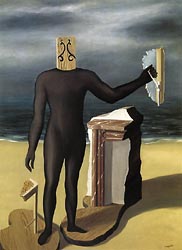
Man of the Open Sea (L'homme du large)- 1926
PART TWO: JUVE VERSUS FANTÔMAS- 1913-1914
Narrative: The main actors crossfade into their characters-in-costume (Juve changes into a hat, a fake mustache and a suit). At the start, Lady Beltham is presumed dead - but actually she’s organizing a gang of bandits who rob passengers on a train car then cause a train accident to cover up their crimes. Our reporter is on the train and escapes with another passenger. He and Juve are lured into a gun trap, but they escape and tail the woman, getting her to lead them to Fantomas, who escapes by putting on his suit with false arms then simply running away, leaving Juve and Fandor each holding an arm! Fantomas has a list of people he’s having mysteriously squeezed to death, so Juve wears spiked bands over his body when he goes to sleep and has Fandor hide in the room - wakes up being choked by a boa constrictor. Later, they’ve figured out where Fantomas hides out, so they storm the house and kill the boa but the criminal mastermind Fantomas was hiding in a tank of water in the basement, escapes, and blows up the house!! Will the cops survive??
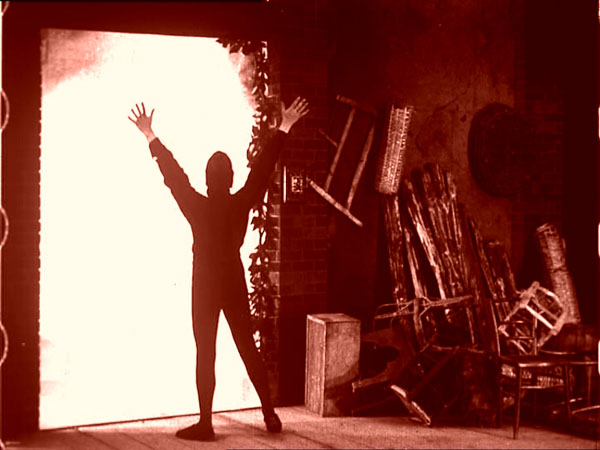
Fantomas in the final scene blowing up the house (1913-1914)
In The Savage (Le barbare, 1928) (see first pic above- top of page) Magritte painted a portrait of Fantômas fading in and out of a brick wall. Both Difficult Crossing (La traversée difficile, 1926) and One Night's Museum (Le musée d'une nuit, 1927) prominently feature severed hands, an image from Gino Starace's cover for La main coupée (The Severed Hand).
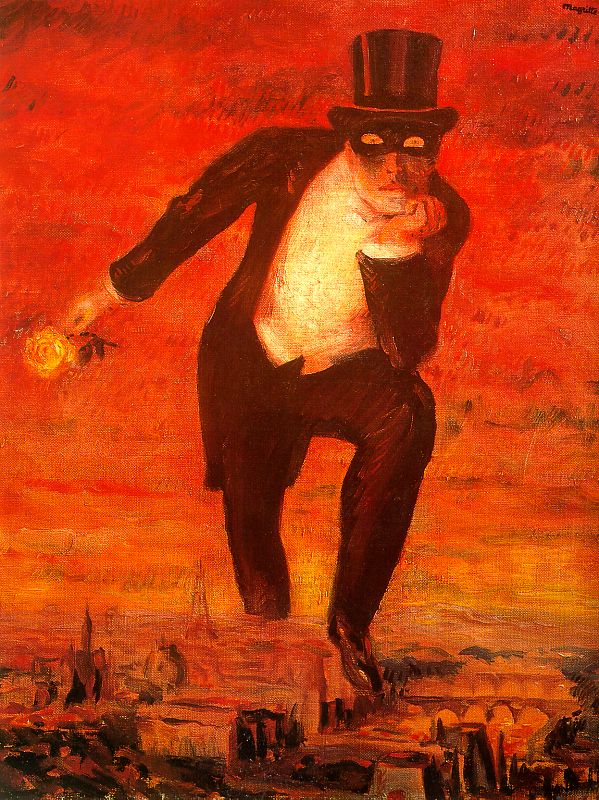
(Le retour de flamme, 1943)
The Backfire (Le retour de flamme- 1943) is a copy of the original cover (below) for the first novel in the series, only in Magritte's painting Fantômas grasps a flower instead of a dagger.
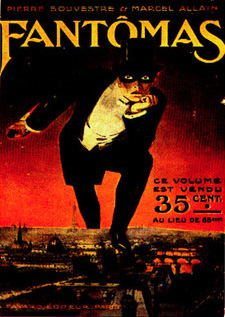
Original cover copied by Magritte
Magritte also wrote several texts featuring the Lord of Terror; this one was published in the journal Distances in March, 1928:
A THEATRICAL EVENT. Juve has been on the trail of Fantomas for quite some time. He crawls along the broken cobblestones of a mysterious passage. To guide himself he gropes along the walls with his fingers. Suddenly, a whiff of hot air hits him in the face. He comes nearer...His eyes adjust to the darkness. Juve distinguishes a door with loose boards a few feet in front of him. He undoes his overcoat in order to wrap it around his left arm, and gets his revolver ready. As soon as he has cleared the door, Juve realizes that his precautions were unnecessary: Fantômas is close by, sleeping deeply. In a matter of seconds Juve has tied up the sleeper. Fantômas continues to dream — of his disguises, perhaps, as usual. Juve, in the highest of spirits, pronounces some regrettable words. They cause the prisoner to start. He wakes up, and once awake, Fantômas is no longer Juve's captive. Juve has failed again this time. One means remains for him to achieve his end: Juve will have to get into one of Fantômas's dreams — he will try to take part as one of its characters. (Translation by Suzi Gablik, from Magritte. Boston: New York Graphic Society 1976)